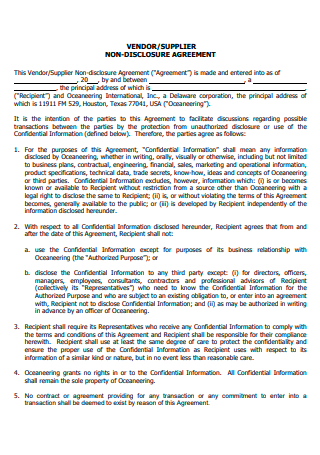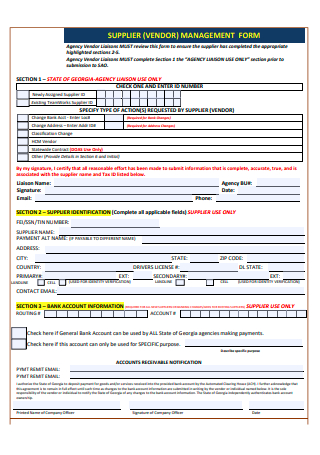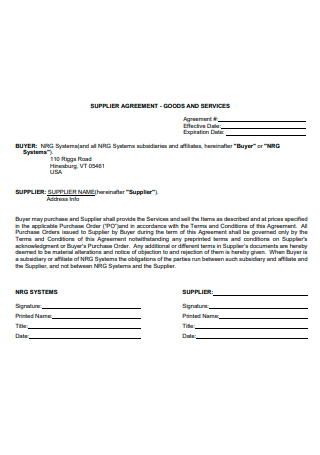3+ Sample Vendor Supplier Agreement
FREE Vendor Supplier Agreement s to Download
3+ Sample Vendor Supplier Agreement
What Is a Vendor Supplier Agreement?
What Is a Vendor?
Types of Vendors
Significance of Having a Good Supplier Relationship
Tips On How to Make a Vendor Supplier Agreement
FAQs
What Is the Difference Between a Supplier and a Vendor?
What Makes Up the Supply Chain?
Who Can Be Considered as a Vendor?
What Is a Vendor Supplier Agreement?
A vendor supplier agreement is a formal agreement between a supplier and a vendor that details the services and items provided directly by the supplier, as well as the standards and policies to which the two parties must comply. The agreement may include information about the pricing set for the products, as well as the service supplier agreement about the amount of products to be delivered, and the percentage of profit that will be shared by both parties. A vendor supplier agreement may include a vendor non-disclosure agreement that both the vendor and supplier must agree in addition to a sale and purchase agreement. Some great relationships are formed through an exclusive vendor deal, for example, and when both parties are already long-term collaborators.
What Is a Vendor?
According to Investopedia.com, a “vendor” is the company that generates goods and services to sell to customers and businesses. Vendors are typically referred to as the party that receives payment for the goods but are not always the party that manufactures them, which in this case is the supplier. A vendor, on the other hand, can be both a supplier (maker) and a seller (for example: retailers).
Types of Vendors
There are numerous benefits to becoming a vendor, especially if you have loyal clients or your product is in high demand in the market. It generates a lot of money. However, before deciding to be a vendor in a vendor partnership agreement with a supplier, you must first determine what type of vendor you want to be.
Significance of Having a Good Supplier Relationship
A vendor-supplier partnership may appear to be a frigid relationship. It’s simply a purchase and sell. However, when there is an agreement in between, particularly in long-term vendor agreements, trust is created through time and grows into a strong connection, which is why you, as a vendor, should cultivate a good relationship with your suppliers. And here’s some reason why:
Tips On How to Make a Vendor Supplier Agreement
A solid written agreement leads to strong merchant relationships. If a transaction fails, both parties suffer. When a loophole is exploited, the other party suffers tremendously. It is even more difficult to develop confidence if it is ambiguous. Consider the suggestions we’re about to give you while creating your vendor supplier agreement.
Tip 1: Firmly Establish the Services and Goods to Be Provided
In order to give what is required of them, a supplier must first understand what is expected of them. The importance of being firm and explicit cannot be overstated. This is essential in a negotiation. Suppliers may be unwilling to give their goods and may only cater to specific needs, so determine what is required to strike an agreement. It is also useful in setting expectations for both parties and avoiding disputes and discontent.
Tip 2: Establish Pricing and Payment Method
Before a vendor decides on their pricing for the general market, the pricing from suppliers may be critical. Pricing would also have to account for shipping costs, as well as factory costs and labor. Pricing would have to be agreed with by both parties. They must also agree on a payment method, just as they would in any other vendor-customer relationship. Payment in full may be required only after all supplies have been delivered. Smoothing out the service delivery plans, pricing the goods, and establishing the payment method would be easy for both financial teams following, just like in any company transaction.
Tip 3: Delivery Times
Deliveries are an important aspect of supplying a product. Most importantly, a prompt delivery. Delivery times would aid in preventing delays and inconvenient situations for both parties. A delay would have ramifications for the suppliers based on the agreement, as there is also financial harm to the vendors. The distribution times would have to be arranged based on consumer demand; it may be quarterly, monthly, or yearly delivery. A delivery time would also set an expectation on the receiver’s part; they might have to close their shop, for example, or open the warehouse. Unexpected deliveries would simply be inconvenient.
Tip 4: Quality and Quantity of the Product
The amount of the goods may be important in determining the pricing set by the suppliers. The greater the quantity, the cheaper the price and a better and easier deal for the vendor. The quality agreement between the two parties is simply what one would expect from a regular vendor agreement. After all, determining what qualifies to be called high-quality would be easier when determining what is acceptable to vendors and customers also.
Tip 5: Termination and Ramifications
Unfortunately, not all agreements are carried out. There may be incidents that neither party anticipated, or a sudden market instability that jeopardizes the financial aspect. In any event, what constitutes termination and the repercussions for failing to deliver or create the agreed-upon goods and services should be established. Because this would aid in determining the exact expectation and allowed errors on both sides. Failure to pay, for example, within a certain time frame, should be a legal ground to end a contract. Multiple delays, on the other hand, should have consequences. If such provisions are not included in the agreement, neither party will be able to build a good working relationship.
FAQs
What Is the Difference Between a Supplier and a Vendor?
Although the terms supplier and vendor are often used interchangeably, a supplier is typically defined as the institution that manufactures items from raw materials and distributes them in big quantities to vendors such as retailers or wholesalers. These vendors would then offer their products to the general public or another reseller. If it is for public consumption, the quantity is usually less than what is directly provided by manufacturers.
What Makes Up the Supply Chain?
A supply chain is a complex but interconnected network of people and businesses. The manufacturers or producers, who create items from raw materials, would be at the top of the list. Then there are suppliers like retailers and wholesalers. There is a transportation system in place to distribute a product, as well as a distribution hub where things are transported out in bulk. Of course, there’s also marketing, finance, and operations to consider. Finally, there is client service.
Who Can Be Considered as a Vendor?
A vendor is any person or entity that sells items and services to major institutions, small businesses, or individual consumers. They could provide long-term or one-time services. And their product costs are frequently greater than the manufacturer’s pricing because shipping and distribution costs are already factored in.
A vendor supplier agreement must take many factors into account, including supply periods, quantities and quality, and cost. And you must carefully consider them in order to have a smooth and easy process. As a vendor or supplier, your purpose is not only to make a profit, but also to produce high-quality goods. So, before you start looking for sample vendor supplier agreement templates or sample vendor supplier contracts, make sure you already know how you’re going to approach them!




